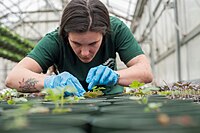
An In-Depth Understanding of Biomass Recalcitrance Using Natural Poplar Variants as the Feedstock.
Sign Up to like & getrecommendations! Published in 2017 at "ChemSusChem"
DOI: 10.1002/cssc.201601303
Abstract: In an effort to better understand the biomass recalcitrance, six natural poplar variants were selected as feedstocks based on previous sugar release analysis. Compositional analysis and physicochemical characterizations of these poplars were performed and the… read more here.
Keywords: natural poplar; biomass recalcitrance; recalcitrance; poplar variants ... See more keywords

Thermogravimetric, thermochemical, and infrared spectral characterization of feedstocks and biochar derived at different pyrolysis temperatures.
Sign Up to like & getrecommendations! Published in 2018 at "Waste management"
DOI: 10.1016/j.wasman.2018.05.048
Abstract: Biochar is a promising biomass product for soil amendment, remediation, and carbon sequestration. In this study, the effect of pyrolysis temperature and feedstock type on biochar physiochemical properties including stability, recalcitrance, and surface functionality were… read more here.
Keywords: pyrolysis; biochar; thermogravimetric thermochemical; thermochemical infrared ... See more keywords

Contribution of structural recalcitrance to the formation of the deep oceanic dissolved organic carbon reservoir
Sign Up to like & getrecommendations! Published in 2018 at "Environmental Microbiology Reports"
DOI: 10.1111/1758-2229.12697
Abstract: The origin of the recalcitrant dissolved organic carbon (RDOC) reservoir in the deep ocean remains enigmatic. The structural recalcitrance hypothesis suggests that RDOC is formed by molecules that are chemically resistant to bacterial degradation. The… read more here.
Keywords: structural recalcitrance; doc; dissolved organic; organic carbon ... See more keywords

Development and use of a switchgrass (Panicum virgatum L.) transformation pipeline by the BioEnergy Science Center to evaluate plants for reduced cell wall recalcitrance
Sign Up to like & getrecommendations! Published in 2017 at "Biotechnology for Biofuels"
DOI: 10.1186/s13068-017-0991-x
Abstract: BackgroundThe mission of the BioEnergy Science Center (BESC) was to enable efficient lignocellulosic-based biofuel production. One BESC goal was to decrease poplar and switchgrass biomass recalcitrance to biofuel conversion while not affecting plant growth. A… read more here.
Keywords: bioenergy science; lignin; switchgrass; transformation ... See more keywords

Multiple levers for overcoming the recalcitrance of lignocellulosic biomass
Sign Up to like & getrecommendations! Published in 2019 at "Biotechnology for Biofuels"
DOI: 10.1186/s13068-019-1353-7
Abstract: BackgroundThe recalcitrance of cellulosic biomass is widely recognized as a key barrier to cost-effective biological processing to fuels and chemicals, but the relative impacts of physical, chemical and genetic interventions to improve biomass processing singly… read more here.
Keywords: plant; biomass; augmentation; choice ... See more keywords

Overcoming cellulose recalcitrance in woody biomass for the lignin-first biorefinery
Sign Up to like & getrecommendations! Published in 2019 at "Biotechnology for Biofuels"
DOI: 10.1186/s13068-019-1503-y
Abstract: BackgroundLow-temperature swelling of cotton linter cellulose and subsequent gelatinization in trifluoroacetic acid (TFA) greatly enhance rates of enzymatic digestion or maleic acid–AlCl3 catalyzed conversion to hydroxymethylfurfural (HMF) and levulinic acid (LA). However, lignin inhibits low-temperature… read more here.
Keywords: lignin; digestion; conversion; enzymatic digestion ... See more keywords

Modeling Polygenic Antibiotic Resistance Evolution in Biofilms
Sign Up to like & getrecommendations! Published in 2022 at "Frontiers in Microbiology"
DOI: 10.3389/fmicb.2022.916035
Abstract: The recalcitrance of biofilms to antimicrobials is a multi-factorial phenomenon, including genetic, physical, and physiological changes. Individually, they often cannot account for biofilm recalcitrance. However, their combination can increase the minimal inhibitory concentration of antibiotics… read more here.
Keywords: biofilm recalcitrance; resistance; modeling polygenic; recalcitrance ... See more keywords